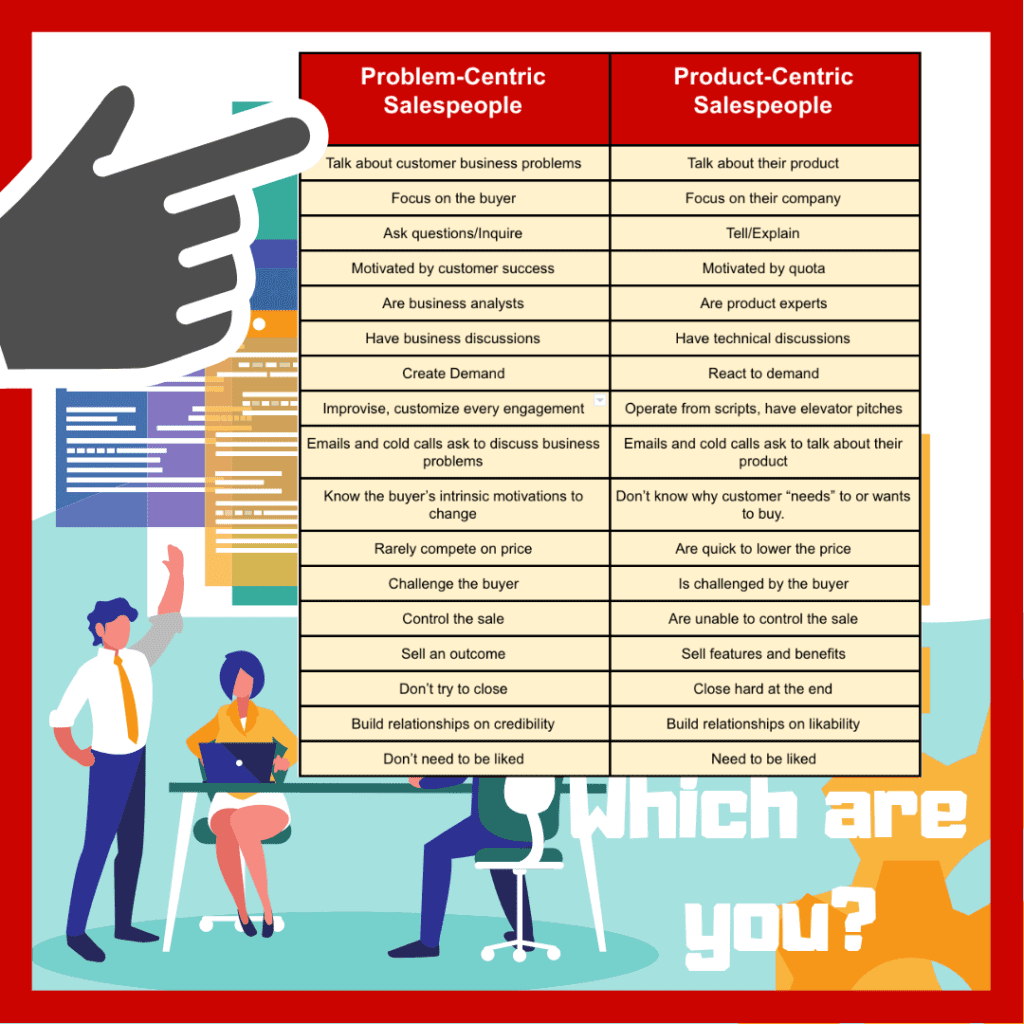Selling today and for the majority of the history of sales has been product-centric. In other words, the sales process, our sales conversations, our sales engagement has been focused on the product and what the product can do.
In post three, I’m tackling how the culture of sales is broken. In many ways, I argue it’s never been “right” or fixed. Take a look at how you sell, look at the majority of your sales training, listen to your sales conversations, and it will become somewhat visible to you by the end of this post.
Think about it for a second, what do we say when we’re asked to do our elevator pitch? Yeah, you know what I’m talking about. We spend 30 seconds talking about the product, it’s features and what it helps people do. It usually starts with; We help people . . . blah, blah, blah. We’re obsessed with our product (as we should be). And because of this, we jump on any chance we can to talk about it.
You don’t believe me? Look at your cold email. Look at your website. Look at your marketing materials. Listen to your sales calls, they are almost always focused on the product; it’s features and benefits, your company, and what some claim of your products greatness. I recently read some sales advice that suggested that because we know our product or service isn’t perfect, we should offer to share upfront where the competition is better by asking the following question:
“Would it be helpful if I started with where they are better than us?”
This is the ideal example of product-centric selling. It forces the rep to compete on features and functions, not on unique, customer-centric problem resolution. You can’t possibly tell a buyer where your competition is better than you if you don’t know what problems they are facing, and what outcomes they are looking to achieve. You see, your product is the solution to a problem or set of problems, and depending on what challenges your prospecting is facing, your product may be better than the competitions. In other situations or environments, your competitions maybe better. Therefore, it’s impossible in product-centric selling to claim that one product, service, or offering is better than another without understanding the problem.
It’s time we problem-centric sell. Problem-centric selling is the concept where the problem drives the discussion, not the product. It’s accepting the notion that people don’t want products or services, they don’t want your widget, they want what your widget can deliver. They want the output. They want to change from a negative environment today, to a more positive one tomorrow.
Problem-centric selling puts the problem at the center of the table. It shifts the conversation from the seller and their products and services to the buyer and their problems and issues. It focuses the selling effort on the buyer’s business, the challenges they are having, the root cause of those challenges, the impact the challenges are having on the organization, and more.
Problem-centric selling recognizes that every buyer’s problems manifest themselves differently, that no two organizations can ever have the same problem and therefore doing the work to understand each of your buyer’s unique problems and the impacts they cause to the organization is the most critical element of the sale. Even more significant than whatever product or service you’re selling.
Switching from a product-centric seller to a problem-centric seller is difficult. It starts with changing how you engage with buyers and where you focus your energy, time, and thought processes. The graphic below highlights the differences between product-centric sellers and problem-centric sellers where and how they operate differently.

Product-centric selling is self-absorbed and puts you, your company, and your product at the center of the sale. Problem-centric selling puts the buyer, their challenges, their problems, and their desired outcomes at the center of the sale and isn’t that the way it’s supposed to be?
It’s time we change the way we sell. It’s time we stop focusing on us, and our products and our goals and start focusing on our buyers. It’s time we change the conversation to look more like problem-centric salespeople than to product-centric salespeople.
Remember, it’s not about us, it’s about them. Let’s start acting that way.



0 Comments